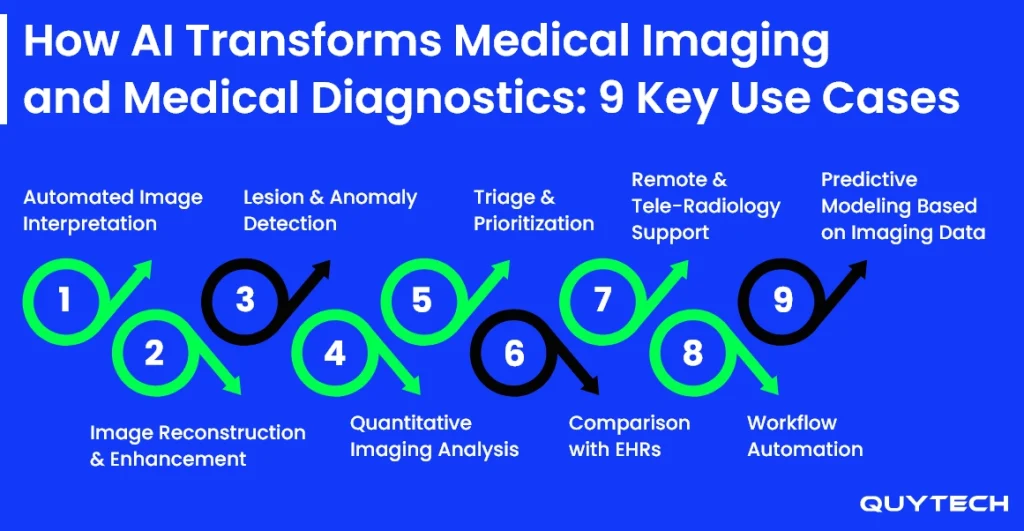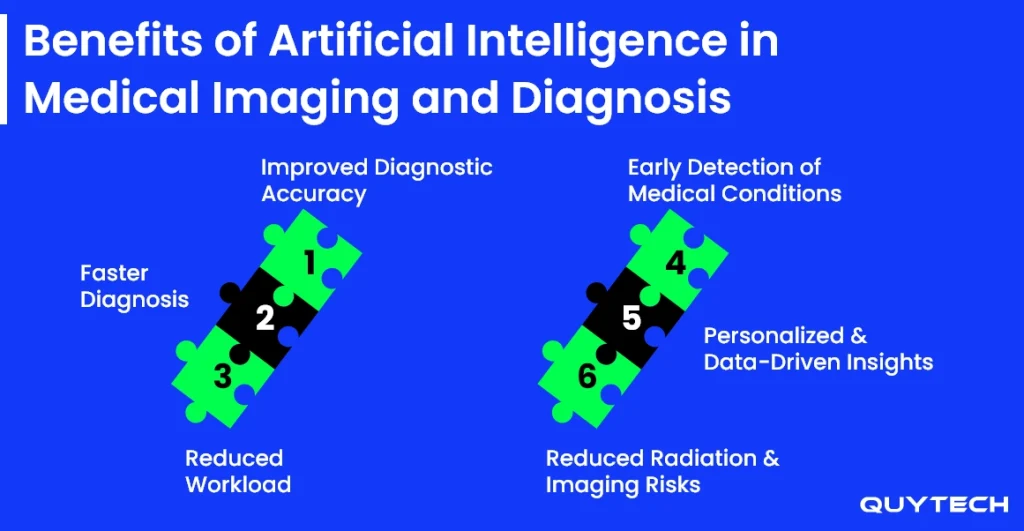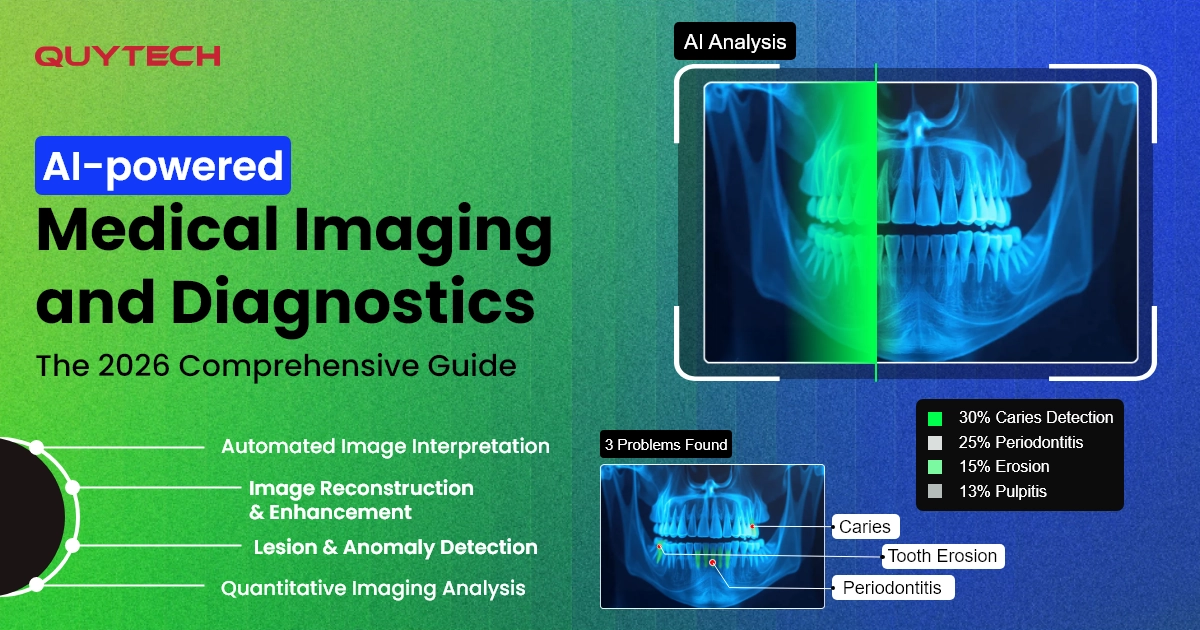We are all aware of the transformative potential of artificial intelligence in healthcare. Whether it is operations management or offering remote healthcare services, AI aids the healthcare industry in many ways. But what many of us don’t know is that the technology can also transform medical imaging and diagnostics.
AI-powered medical imaging and diagnostics can be a companion for radiologists; it automates analyzing, processing, and comprehending medical scans and images. In fact, with 90% of radiologists (a study conducted on more than fifty radiologists in the USA) mentioning that their workload has increased significantly over the last three years, using AI is no longer optional.
Analyzing medical images or scans using traditional methods requires significant time. Besides, they are also prone to errors. On the contrary, artificial intelligence in medical imaging enhances the speed and precision of disease diagnosis. It also empowers medical professionals, such as clinicians, to design the most effective and highly personalized treatment plan.
Interesting, isn’t it? Let’s delve deeper into this blog to explore how AI in medical imaging or diagnosis works, what benefits it offers, the technologies and tools that play a vital role, and a lot more.
Let’s begin!
What is AI in Medical Imaging?
Medical imaging paves the foundation of the healthcare industry. It enables clinicians or radiologists to easily diagnose and treat diseases or health problems by looking into the visuals captured during X-rays, CT Scans, MRIs, and other scans.
The right analysis of these scans also aids in designing a highly effective treatment plan. However, analyzing and interpreting those images or scans totally depends on the expertise and experience of the clinician or radiologist. It is quite common that the opinion of one radiologist may differ from others, which may further lead to problems in disease diagnosis and treatment planning.
AI in medical imaging eliminates this problem by ensuring the accurate analysis and interpretation of each scan every time. Artificial intelligence, along with machine learning and deep learning, medical imaging can even detect patterns that human eyes might miss. These patterns can play a vital role in finding the best treatment or cure for a disease.
What is AI in Medical Diagnosis?
As mentioned in the previous section, the accuracy of any medical diagnosis depends on the experience and proficiency of a radiologist in analyzing and interpreting medical images, such as X-rays and MRIs. Here, one cannot guarantee diagnostic precision and accuracy for each scan or medical image, especially when dealing with complex diseases.
AI in medical diagnosis overcomes this challenge and facilitates data-driven decision-making to diagnose a medical problem by accurately analyzing a medical image. It relies on machine learning, NLP, and deep learning to process extensive databases and provide accurate results in no time.
How AI Transforms Medical Imaging and Medical Diagnostics: 9 Key Use Cases
AI-powered medical imaging and diagnostics utilize highly advanced AI and ML algorithms to analyze scans without manual intervention. The technology brings unmatched speed, accuracy, and efficiency in diagnosis. Here are the use cases of AI in medical imaging and applications of AI in medical diagnosis:

#1 Automated Image Interpretation
AI medical imaging facilitates seamless reading and comprehension of X-rays, CT scans, and MRIs. AI-powered medical imaging solutions work as medtech professionals or clinicians who can identify patterns and analyze visual representations of internal body structures or organs to mark the areas that might need attention. Medical imaging AI ensures nothing critical is missed.
#2 Image Reconstruction and Enhancement
The next amazing application of AI in medical imaging is that it can even reconstruct or enhance low-quality images, which might happen due to lower doses of radiation or any other reason. Artificial intelligence in medical imaging can reconstruct those scans or enhance them for clarity and accurate diagnosis. It can even remove blurriness and make the scan sharper for better representation without making the patient go through the scan again.
#3 Lesion and Anomaly Detection
Medical imaging AI can easily identify odd shapes or lesions. The technology empowers doctors to even detect unexpected structures or organ growth within the body. This helps in precisely diagnosing every disease that may turn into a bigger health problem if it gets missed during the diagnosis.
Discover how it works: Anomaly Detection Guide: Use Cases, Types, Methods, Benefits, and More
#4 Quantitative Imaging Analysis
Artificial intelligence can measure even the minute things within each scan. Now, this could be measuring a particular organ or checking the thickness of tissues. Clinicians can make the right decisions based on the numbers and facts, rather than based on assumptions or a patient’s medical history.
#5 Triage and Prioritization
Artificial intelligence in medical diagnosis can quickly scan images and mark critical problems. It can also tell the severity of the disease so that clinicians can mark patients who need immediate treatment or attention.
#6 Comparison with EHRs
Medical diagnosis AI has the capability to combine or merge images with the patient’s electronic health records, which could be their previous lab tests or scans. By analyzing previous scans and comparing them with the latest one, AI can find patterns and detect anomalies to provide doctors a better picture of the patient’s health.
#7 Remote and Tele-Radiology Support
Artificial intelligence in medical diagnosis empowers healthcare professionals to remotely review scans. Doing this accurately is difficult if they have to analyze the scans over video calls or shared screens. AI in medical imaging and diagnosis makes it easier for doctors to get a view of the highlighted areas in the scans.
Take a look at this: AI in Remote Patient Monitoring: Improving Healthcare Accessibility and Convenience
#8 Workflow Automation
AI in medical diagnosis automates repetitive tasks, which saves time and effort. Here, we are talking about tasks like labelling scans, sorting files of each patient, and generating preliminary reports. Medical imaging powered by AI saves clinicians and radiologists from performing routine tasks that are not of high value.
#9 Predictive Modeling Based on Imaging Data
One of the best use cases of AI in medical diagnosis is that it can predict the chances of disease by analyzing previous scans. Based on the analysis, healthcare professionals can offer preventive care or recommendations. For example, AI for medical diagnosis can identify subtle signs that may turn into cancer.
Discover More: How AI Is Transforming the Healthcare Industry: Discover the Top Ways
Technologies and Techniques Used in AI Medical Imaging and Diagnosis
AI in medical imaging and diagnostics involves several advanced technologies and techniques working together to analyze complex medical data and offer required insights. These technologies are:
#1 Machine Learning
Machine learning’s supervised and unsupervised learning techniques are used to train models on labeled datasets for the easy classification of new medical images or medical records of patients.
Unsupervised learning facilitates the seamless identification of hidden patterns to find out correlations that are not known. ML also enables AI-powered medical imaging solutions capable of self-learning from historical and real-time data. Two other techniques that are used for medical imaging and diagnostics purposes are support vector machines and random forests.
Also Read: Health Risk Assessment Using AI/ML
#2 Deep Learning and Neural Networks
Deep learning utilizes multi-layered neural networks to analyze medical images and fetch features. The techniques that are used are convolutional neural networks, autoencoders, and recurrent neural networks.
CNNs are used for the analysis, segmentation, and pattern recognition in medical images. RNNS are used to process sequential data, and autoencoders do the job of compressing medical images without disturbing their critical features.
#3 Generative Adversarial Networks (GANs)
GANs combine two neural networks, which are a generator and a discriminator. They are used to generate synthetic medical images and improve the resolution of images. GANs can also reconstruct the medical images that are blurred. Reducing noise in a low-quality scan is another key characteristic of GAN.
Continue Reading: Metaverse in Healthcare: Benefits, Development Process, & More
#4 Natural Language Processing (NLP)
NLP enables AI-powered medical imaging and diagnostics systems to understand and analyze unstructured text data from multiple sources. These sources include records collected from EHR systems, lab reports, and clinical notes. The technology fetches relevant medical information, maps symptoms and diagnoses to help medical professionals make decisions, and also summarizes patients’ history to ensure a quick review by clinicians.
You may like this: How Blockchain Being Used in Healthcare: Use Cases, Benefits
#5 Computer Vision
Computer vision techniques are used to process and analyze visual data from X-rays, MRIs, and other scans. Based on the analysis, it finds anomalies and classifies organs. When used with deep learning, it can build a foundation for advanced AI imaging solutions.
#6 Predictive Analytics
AI-powered systems for medical imaging and diagnostics also utilize predictive analytics to forecast the progression of diseases. It also helps in identifying high-risk patients and recommending preventive strategies that can prevent diseases or their progression.
Get Insights: How Predictive Analytics is Transforming the Healthcare Industry
Benefits of Artificial Intelligence in Medical Imaging and Diagnosis
Artificial intelligence offers amazing benefits that empower medtech professionals to bring additional accuracy and expertise to their work. Let’s take a look at the key advantages of AI in medical imaging and diagnosis:

#1 Improved Diagnostic Accuracy
AI-powered medical imaging and diagnostics improve the accuracy of diagnosis. For each scan, the accuracy of detecting anomalies and identifying patterns remains consistent, even if it has to do over a hundred scans every day.
You may also like to read: Role of Artificial Intelligence in Legal Firms: Enhancing Efficiency and Accuracy
#2 Faster Diagnosis
Artificial intelligence, when used for medical imaging analysis, improves the speed of diagnosis by automating repetitive tasks. Labelling and creating preliminary reports can be done within minutes, that too, without manual intervention.
#3 Reduced Workload
Automation of tasks minimizes the workload on clinicians. While AI does its job, clinicians can do other critical work or focus on further investigations in the reports. It also helps with improving workflow efficiency.
Similar Read: Top Use Cases and Benefits of AI in Healthcare
#4 Early Detection of Medical Conditions
AI-powered medical imaging and diagnostics systems facilitate the identification of health problems or medical conditions at an early stage. This empowers healthcare professionals to take preventive measures.
#5 Personalized and Data-Driven Insights
Artificial intelligence in medical diagnosis can help design personalized treatment plans by analyzing current and past medical history and lab results. These data-driven insights ensure that the treatment is going in the right direction.
Delve Deeper: AI in Healthcare Data Analytics: Cutting Readmission Rates
#6 Reduced Radiation and Imaging Risks
As mentioned earlier in the use cases of AI-powered medical imaging and diagnostics, AI can reconstruct low-quality or blurred medical images. This reduces the cases where the patient has to do the test again.
You might be interested in: AI in Healthcare: Drives Potential Enhancements across the Healthcare Sector
Challenges You May Face While Using AI for Medical Imaging and Diagnostics
While implementing AI for medical imaging and diagnostics, one may face several challenges, including:
- Poor data quality
- Lack of relevant data
- Inefficient data privacy and security measures
- Inability to integrate with existing systems
- Difficulty in the interpretability of AI Models
- Regulatory and compliance hurdles
- The cost of implementation
- Lack of training for using the system to its full potential
- Maintaining model performance over time
To overcome these issues, one of the ways is to partner with a reliable and highly experienced AI development company that has prior experience in building AI-powered healthcare systems and applications. They will provide you with proper guidance before and after the implementation of the AI-powered medical imaging and diagnostics.
Explore this blog: The Importance of Data Privacy and Security in Healthcare Apps
Implement AI for Medical Diagnostics and Imaging in 5 Steps
Here are the steps to implement AI in medical imaging and diagnostics:
Step 1: Define Clinical Use Cases
To implement AI in medical diagnostics and imaging, firstly, identify clinical use cases and medical imaging needs. You need to clearly mention which medical images will benefit from AI and what purpose (anomaly detection, image enhancement, segmentation, etc.) it will solve.
Step 2: Data Collection and Annotation
Now, data collection is the next step. While doing so, you need to be mindful of two things: the quality of the data and the sources of the data. Make sure you choose the right and relevant data. Make sure the data is consistent, labeled, and structured so that it can be used for AI model training.
Step 3: Selection of AI Techniques
Choose the right artificial intelligence technique and technology depending on the goal you want to achieve. For instance, you can use CNNS for image recognition and segmentation. Similarly, use NLP for automated interpretation of reports.
Step 4: Training and Verifying AI Models
Train AI models on the annotated imaging datasets. Once the models are trained, test their performance and whatever output they generate, and ask experienced radiologists to review the output.
Step 5: Integrate AI into Radiology Workflows
The next step is to deploy artificial intelligence within PACS, RIS, and EHR systems. This will ensure that your systems and workflows are now backed up with AI for smart functioning and intelligent support in decision-making.
Make sure they comply with industry standards and regulations. Also, ensure that you continuously update these systems and the equipped AI/ML models on new data for improved accuracy and performance.
Leading Healthcare Organizations Using Artificial Intelligence in Medical Imaging and Diagnostics
Leading MedTech companies and healthcare organizations are already using AI-powered medical imaging and diagnostics; let’s take a look at three big names:
#1 St. Luke’s University Health Network (USA)
St. Luke’s chain of 16 hospitals and more than 300 clinics across Pennsylvania and New Jersey uses AI tools in its urgent care clinics. These tools and AI-powered solutions enable radiologists to detect fractures and bone-related abnormalities with high accuracy and speed.
#2 Johns Hopkins Medicine (USA)
Johns Hopkins Medicine in the United States of America is another example of AI in medical imaging and diagnostics. It uses FDA-approved AI tools to support its radiology departments with mammography analysis. The installed AI systems help in the identification of possible issues and the early detection of cancer.
#3 AIIMS (India)
AIIMS (Raipur, India) has also upgraded its nuclear medicine infrastructure with artificial intelligence. The hospital has implemented automated radio synthesizers and Gallium generators to generate PET radio tracers for precise cancer diagnostics and design personalized plans.
How Quytech Empowers the Medtech Industry to Utilize AI-Powered Medical Imaging and Diagnostics
Quytech empowers healthcare and MedTech industries to make the most of artificial intelligence technology to accelerate diagnostics without compromising the accuracy of the outcomes. We are the top AI-powered healthcare app development company that has dedicated AI and ML experts who leverage the right ML and deep learning capabilities to build AI-powered solutions for medical imaging and diagnostics or implement AI in your existing systems.
These customized and scalable solutions enable clinicians and radiology professionals to analyze even complex medical images and make data-backed decisions. We ensure that each system we develop can also be integrated with PACS and EHRs to ensure clinical workflow management and automation.
What makes us a preferred technology partner for hundreds of healthcare organizations is our proven experience in developing 100+ healthcare apps and solutions, including:
- Telemedicine apps
- Remote patient monitoring solutions
- Clinic management solutions
- Medical imaging solutions
- Healthcare management apps
- AI-powered cancer prediction apps
Future Trends in AI for Medical Imaging and Diagnostics
With artificial intelligence offering so many amazing benefits in medical diagnosis and diagnostics, it is clear that the future of this technology in this field is quite promising. In 2026 and beyond, we may see multi-modal AI systems that consider imaging, genomics, and patient records all together to generate even more accurate diagnostics.
Real-time AI analysis could be a future trend of AI in medical diagnostics. This trend will help healthcare professionals analyze scans during the scanning process. Another future trend in AI-powered medical imaging and diagnostics could be federated learning and privacy-preserving AI, which will ensure the security of patient data.
We may also see integration of AI-powered medical imaging and diagnostics with telemedicine and portable imaging devices to expand access to diagnostic support.
Also Explore: Latest Healthcare Tech Trends
Conclusion
Artificial intelligence in medical imaging and diagnosis brings next-level accuracy and speed by automating the analysis and comprehension of scans. AI helps in detecting anomalies that human clinicians may miss. It can help in accurate and advanced diagnosis of diseases so that healthcare professionals can design the most effective plan or ensure better patient care.
Explore the blog to know the use cases, benefits, challenges, real-world examples, and best practices of implementing AI in medical imaging or AI in diagnosis. If you wish to implement the technology, connect with a reliable partner with in-depth AI expertise and a proven background of serving the healthcare industry.
FAQ
Artificial intelligence in medical imaging and diagnosis can pre-analyze medical scans to find any anomalies. It can also assist radiologists in accurately reviewing images remotely.
Yes, AI models used in building AI-powered medical imaging and diagnosis solution development need to be continuously trained on new data, clinical outcomes, and updated guidelines. This is required to maintain accuracy and relevance over time.
AI acts as a companion and decision-support tool. Clinicians still need to review AI-generated insights before making the final diagnosis. This ensures a patient receives the right care and treatment.
Yes, AI-powered medical imaging and diagnostics tools need to comply with FDA or CE marking and other medical device regulations.
The cost of implementing AI in medical imaging and diagnosis, or building an AI-powered medical imaging and diagnostics solution, depends on the technology requirements, integration needs, data availability, regulatory requirements, and other factors. Reach out to Quytech’s experts for an accurate estimate.



